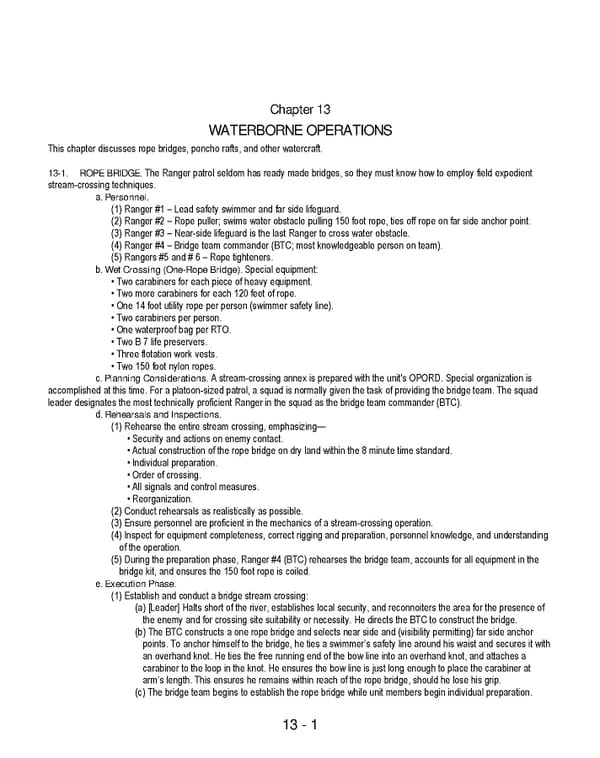13 - 1 Chapter 13 WATERBORNE OPERATIONS This chapter discusses rope bridges, poncho rafts, and other watercraft. 13-1. ROPE BRIDGE. The Ranger patrol seldom has ready made bridges, so they must know how to employ field expedient stream-crossing techniques. a. Personnel. (1) Ranger #1 – Lead safety swimmer and far side lifeguard. (2) Ranger #2 – Rope puller; swims water obstacle pulling 150 foot rope, ties off rope on far side anchor point. (3) Ranger #3 – Near-side lifeguard is the last Ranger to cross water obstacle. (4) Ranger #4 – Bridge team commander (BTC; most knowledgeable person on team). (5) Rangers #5 and # 6 – Rope tighteners. b. Wet Crossing (One-Rope Bridge). Special equipment: • Two carabiners for each piece of heavy equipment. • Two more carabiners for each 120 feet of rope. • One 14 foot utility rope per person (swimmer safety line). • Two carabiners per person. • One waterproof bag per RTO. • Two B 7 life preservers. • Three flotation work vests. • Two 150 foot nylon ropes. c. Planning Considerations. A stream-crossing annex is prepared with the unit's OPORD. Special organization is accomplished at this time. For a platoon-sized patrol, a squad is normally given the task of providing the bridge team. The squad leader designates the most technically proficient Ranger in the squad as the bridge team commander (BTC). d. Rehearsals and Inspections. (1) Rehearse the entire stream crossing, emphasizing— • Security and actions on enemy contact. • Actual construction of the rope bridge on dry land within the 8 minute time standard. • Individual preparation. • Order of crossing. • All signals and control measures. • Reorganization. (2) Conduct rehearsals as realistically as possible. (3) Ensure personnel are proficient in the mechanics of a stream-crossing operation. (4) Inspect for equipment completeness, correct rigging and preparation, personnel knowledge, and understanding of the operation. (5) During the preparation phase, Ranger #4 (BTC) rehearses the bridge team, accounts for all equipment in the bridge kit, and ensures the 150 foot rope is coiled. e. Execution Phase. (1) Establish and conduct a bridge stream crossing: (a) [Leader] Halts short of the river, establishes local security, and reconnoiters the area for the presence of the enemy and for crossing site suitability or necessity. He directs the BTC to construct the bridge. (b) The BTC constructs a one rope bridge and selects near side and (visibility permitting) far side anchor points. To anchor himself to the bridge, he ties a swimmer’s safety line around his waist and secures it with an overhand knot. He ties the free running end of the bow line into an overhand knot, and attaches a carabiner to the loop in the knot. He ensures the bow line is just long enough to place the carabiner at arm’s length. This ensures he remains within reach of the rope bridge, should he lose his grip. (c) The bridge team begins to establish the rope bridge while unit members begin individual preparation.
 Ranger Handbook Page 236 Page 238
Ranger Handbook Page 236 Page 238